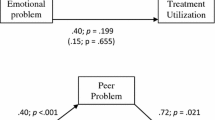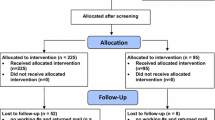Abstract
Children with complex disabilities require comprehensive, coordinated and integrated services. However, parents often find themselves navigating fragmentary service systems—a process that may be more difficult when children exhibit behavioral problems such as hyperactivity and inattention. Such problems are more common among children with disabilities. Thus, the present study examined the familial and economic impact of service integration and child hyperactivity among 111 families involved with a children’s treatment network over 2 years. The most dysfunctional families over time were involved with low-integration teams and had children who were highly hyperactive. Children who were hyperactive and their parents had the highest levels of service utilization at baseline, though these patterns reversed or disappeared over time, respectively. Family functioning was also associated with higher service costs for parents, over time. Results highlight the importance of considering the impact of child hyperactivity and inattention, even when children are receiving services for other primary diagnoses.


Similar content being viewed by others
References
American Psychiatric Association. (2000). Diagnostic and statistical manual of mental disorders, 4th edition-text revision(DSM-IV-TR). Washington, DC: American Psychiatric Press.
Baker, B. L., Blacher, J., Crnic, K. A., & Edelbrock, C. (2002). Behavior problems and parenting stress in families of three-year-old children with and without developmental delays. American Journal of Mental Retardation, 107(6), 433–444.
Barkley, R. A. (2001). Accidents and attention-deficit/hyperactive disorder. TEN, 3, 64–68.
Barkley, R. A. (2002). International consensus statement on ADHD. Clinical Child and Family Psychology Review, 5, 89–111.
Beresford, B. (1995). Expert opinions: a survey of parents caring for a severely disabled child. Policy Press, Bristol.
Borthwick, S. A., Eyman, R. K., & White, J. F. (1987). Client characteristics and residential placement patterns. American Journal of Mental Deficiency, 92, 24–30.
Borthwick-Duffy, S. A. (1994). Epidemiology and prevalence of psychopathology in people with mental retardation. Journal of Consulting and Clinical psychology, 62, 17–27.
Borthwick-Duffy, S. A., & Eyman, R. K. (1990). Who are the dually diagnosed. American Journal of mental Retardation, 94, 586–595.
Boyle, M. H., Offord, D. R., Racine, Y., Fleming, J. E., Szatmari, P., & Sanford, M. (1993). Evaluation of the revised Ontario child health study scales. Journal of Child Psychology and Psychiatry, 34, 189–213.
Browne, G., Byrne, C., Roberts, J., Gafni, A., & Whittaker, S. (2001). When the bough breaks: provider-initiated comprehensive care is more effective and less expensive for sole-support parents on social assistance. Social Science & Medicine, 53, 1697–1710.
Browne, G., Gafni, A., & Roberts, J. (2001). Approach to the measurement of resource use and costs. Hamilton: System-Linked Research Unit, McMaster University.
Browne, G., Roberts, J., Gafni, A., Byrne, C., Kertyzia, J., & Loney, P. (2004). Conceptualizing and validating the human services integration measure. International Journal of Integrated Care, 4, article e03.
Browne, G., Kingston, D., Grdisa, V., & Markle-Reid, M. (2007). Conceptualization and measurement of integrated human service networks for evaluation. International Journal of Integrated Care, 7, article e51.
Browne, D. T., Odueyungbo, A. O., Thabane, L., Byrne, C., & Smart, L. A. (2010). Parenting-by-gender interactions in child psychopathology: attempting to address inconsistencies with a Canadian national database. Child and Adolescent Psychiatry and Mental Health, 4(1), 5 (13 pages).
Browne, D. T., Verticchio, D., Shlonsky, A., Thabane, L., Hoch, J., & Byrne, C. (2010). The family standpoint of investigation: examining the correlates and costs of parental stress in a sample of families involved with Ontario child welfare. Canadian Journal of Community Mental Health, 29(2), 131–154.
Browne, D. T., Meunier, J.-C., O’Connor, T. G., & Jenkins, J. M. (2012). The role of parental personality traits in differential parenting. Journal of Family Psychology. doi:10.1037/a0028515.
Byles, Byrne, C., Boyle, M. H., & Offord, D. R. (1988). Ontario child health study: reliability and validity of the general functioning subscale of the McMaster family assessment device. Family Process, 27(1), 97–104.
Cacioppo, J. T., Bernston, G. G., Sheridan, J. F., & McClintock, M. K. (2000). Multilevel integrative analysis of human behaviour: social neuroscience and the complementing nature of social and biological approaches. Psychological Bulletin, 126, 829–843.
Charach, A., Lin, E., & To, T. (2010). Evaluating the hyperactivity/inattention subscale of the National Longitudinal Survey of Children and Youth. Health Reports, Statistics Canada, 21(2), 1–9.
Cossette, L., & Duclos, E. (2002). A profile of disability in Canada, 2001. Statistics Canada Housing Family and Social Statistics Division. Ottawa: Minister of Industry.
Eyman, R. K., & Borthwick-Duffy, S. A. (1980). Patterns of care for mentally retarded persons. Mental Retardation, 18, 63–66.
Eyman, R. K., & Call, T. L. (1977). Maladaptive behavior and community placement of mentally retarded persons. American Journal of Mental Deficiency, 82, 137–144.
Gadow, K., & DeVincent, C. (2005). Clinical significance of tics and attention-deficit hyperactivity disorder in children with pervasive developmental disabilities. Journal of Child Neurology, 20(6), 481–488.
Guerriere, D. N., Ungar, W. J., Corey, M., Croxford, R., Tranmer, J. E., Tullis, E., et al. (2006). Evaluation of the ambulatory and home care record: agreement between self-reports and administrative data. International Journal of Technology Assessment in Health Care, 22(2), 203–210.
Guevara, J., Lozano, P., Wickizer, T., Mell, L., & Gephart, H. (2001). Utilization and cost of health care services for children with attention-deficit/hyperactivity disorder. Pediatrics, 108, 71–78.
Herring, S., Gray, K. M., Taffe, J., Tonge, B. J., Sweeney, D., & Einfeld, S. L. (2006). Behavioural and emotional problems in toddlers with a pervasive developmental disorder and developmental delay: associations with parental mental health and family functioning. Journal of Intellectual Disability Research, 50(12), 874–882.
Jenkins, J. M., Rasbash, J., & O’Connor, T. G. (2003). The role of shared family context in differential parenting. Developmental Psychology, 39(1), 99–113.
Johnston, C., & Mash, E. J. (2001). Families of children with attention-deficit/hyperactivity disorder: review and recommendations for future research. Clinical Child and Family Psychology Review, 4, 183–207.
Konrad, K., & Kickhoff, S. B. (2010). Is the ADHD brain wired differently? A review on structural and functional connectivity in attention deficit hyperactivity disorder. Human Brain Mapping, 31(6), 904–916.
Lansisalmi, H., Kivimaki, M., Aalto, P., & Ruoranen, R. (2006). Innovation in healthcare: a systematic review of recent research. Nursing Science Quarterly, 19(1), 66–72.
Levine, S., & White, P. E. (1969). Exchanges as a conceptual framework for the study of interorganizational relationships). In A. Etzioni (Ed.), A sociological reader on complex organizations (2nd ed., pp. 117–132). New York: Hold, Rinehart & Winston.
Lyons, J. S. (2004). Redressing the emperor: Improving the children’s public mental health system. Westport, CT: Praeger.
Mannuzza, S., & Klein, R. G. (2000). Long-term prognosis in attention-deficit/hyperactivity disorder. Child Adolescent Psychiatry Clinics of North America, 9, 711–726.
Mash, E., & Wolfe, D. A. (2005). Abnormal child psychology (3rd Ed.) Chapter 5: Attention-deficit/hyperactivity disorder (ADHD). Canada: Wadsworth.
Matza, L. S., Paramore, C., & Prasad, M. (2005). A review of the economic burden of ADHD. Cost Effectiveness and Resource Allocation, 3, 1–9.
Meunier, J. C., Bisceglia, R., & Jenkins, J. M. (2011). Differential parenting and children’s behavioral problems: curvilinear associations and mother-father combined effects. Developmental Psychology. doi:10.1037/a0026321.
Milward, H. B., & Provan, K. (2003). Managing the hollow state: collaboration and contracting. Public Management Review, 5(1), 1–18.
Owens, P. L., Hoagwood, K., Horwitz, S. M., Leaf, P. J., Poduska, J. M., Kellam, S. G., & Ialongo, N. S. (2002). Barriers to children’s mental health services. Journal of the American Academy of Child & Adolescent Psychiatry, 41, 731–738.
Rojahn, J., Borthwick-Duffy, S. A., & Jacobson, J. W. (1993). The association between psychiatric diagnoses and severe behavior problems in mental retardation. Annals of Clinical Psychiatry, 5, 163–170.
Rosenbaum, P., King, S., Law, M., King, G., & Evans, J. (1998). Family-centered service: a conceptual framework and research review. Physical and Occupational Therapy in Pediatrics, 18, 1–20.
Sloper, P., & Turner, S. (1993). Risk and resistance factors in the adaptation of patients of children with severe physical disability. Journal of Child Psychology and Psychiatry, 34, 167–188.
Sloper, P., Knussen, C., Turner, S., & Cunningham, C. (1991). Factors related to stress and satisfaction with life in families of children with Down’s syndrome. Journal of Child Psychology and Psychiatry, 32, 655–676.
Statistics Canada. (1994). National longitudinal survey of children and youth, cycle 1—User Guide. Ottawa: Statistics Canada.
Statistics Canada. (2008). National longitudinal survey of children and youth. Ottawa: Statistics Canada. http://www.statcan.gc.ca/
Swensen, A. R., Birnbaum, H. G., Secnik, K., Marynchenko, M., Greenberg, P., & Claxton, A. (2003). Attention-deficit/hyperactivity disorder: increased costs for patients and their families. Journal of the American Academy of Child and Adolescent Psychiatry, 42, 1415–1423.
Thurston, S., Paul, L., Ye, C., Loney, P., Browne, D., Browne, G., Wong, M., Thabane, L., & Rosenbaum, P. (2010). System integration and its influence on the quality of life of children with complex needs. International Journal of Pediatrics, Article ID 570209, 12 pages.
Varni, J. W., & Limbers, C. A. (2009). The Pediatric Quality of Life Inventory: measuring pediatric health-related quality of life from the perspective of children and their parents. Pediatric Clinics of North America, 56, 843–863.
Widaman, K. F., Givvs, K. W., & Geary, D. C. (1987). Structure of adaptive behavior: in replication across fourteen samples of nonprofoundly mentally retarded people. American Journal of Mental Deficiency, 91, 348–360.
Widaman, K. F., Stacy, A. W., & Borthwick Duffy, S. A. (1993). Construct validity of dimensions of adaptive behavior: a multitrait-multimethod evaluation. American Journal on Mental Retardation, 98, 219–234.
Willms, J. D. (2002). Vulnerable children: Findings from Canada’s National Longitudinal Survey of Children and Youth. Edmonton: University of Alberta Press.
Wymbs, B. T., Pelham, W. E., Molina, B. S. G., Gnagy, E. M., Wilson, T. K., & Greenhouse, J. B. (2008). Rate and predictors of divorce among parents of youths with ADHD. Journal of Consulting and Clinical Psychology, 76, 735–744.
Yoshida, Y., & Uchiyama, T. (2004). The clinical necessity for assessing ADHD symptoms in children with high-functioning Pervasive Developmental Disorder. European Child & Adolescent Psychiatry, 13(5), 307–314.
Author information
Authors and Affiliations
Corresponding author
Rights and permissions
About this article
Cite this article
Browne, D.T., Rokeach, A., Wiener, J. et al. Examining the Family-Level and Economic Impact of Complex Child Disabilities as a Function of Child Hyperactivity and Service Integration. J Dev Phys Disabil 25, 181–201 (2013). https://doi.org/10.1007/s10882-012-9295-z
Published:
Issue Date:
DOI: https://doi.org/10.1007/s10882-012-9295-z




